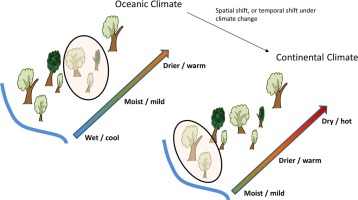当前位置:
X-MOL 学术
›
Forest Ecol. Manag.
›
论文详情
Our official English website, www.x-mol.net, welcomes your
feedback! (Note: you will need to create a separate account there.)
Microclimatic refugia in riparian woodland: A climate change adaptation strategy
Forest Ecology and Management ( IF 3.7 ) Pub Date : 2020-04-01 , DOI: 10.1016/j.foreco.2020.118006 Christopher J. Ellis
Forest Ecology and Management ( IF 3.7 ) Pub Date : 2020-04-01 , DOI: 10.1016/j.foreco.2020.118006 Christopher J. Ellis

|
Abstract There is increasing interest in the role that microclimatic refugia might play in moderating the response of biodiversity to climate change. A key question is how habitat management can proactively generate microclimatic refugia to maintain locally favourable conditions despite macroclimatic change. This study uses woodland epiphytes as a case-study, to answer this question. Field sampled data documented a cross-scale response of the conservation-priority lichen – Lobaria pulmonaria – to macroclimate, and, representing microclimates, the distance to watercourse and bryophyte association. The field sampled response was tested against experimental growth rates in a factorial design with respect to two climatically-contrasting sites (Benmore and Dawyck Botanic Gardens, in northern Britain), four watercourse distances, for lichens with and without bryophyte association. When measured for a summer dry period, the sites, watercourse distances and bryophyte associations had significantly different vapour pressure deficit (VPD) experienced by the lichen thalli, and therefore affecting physiological response. Furthermore, the field sampled response and growth rates were consistent, supporting the use of riparian woodland with a buffer of c. 500 m as an adaptation option that would allow lichen populations to adjust position (further or nearer from a watercourse) as they migrate locally into microclimatic space when responding to macroclimatic change. Microhabitat complexity (areas with and without bryophytes) would facilitate this process. These results are relevant to rare and threatened conservation priority epiphytes – including temperate rainforest species – lending additional support to the bundle of ecosystem services provided by riparian woodland.
中文翻译:

河岸林地的小气候避难所:气候变化适应策略
摘要 人们越来越关注小气候避难所可能在调节生物多样性对气候变化的响应中发挥的作用。一个关键问题是栖息地管理如何能够主动产生小气候避难所,以在大气候变化的情况下维持当地的有利条件。本研究使用林地附生植物作为案例研究来回答这个问题。现场采样数据记录了保护优先的地衣 - Lobaria pulmonaria - 对大气候的跨尺度响应,以及代表小气候、与水道和苔藓植物关联的距离。针对两个气候对比鲜明的地点(英国北部的 Benmore 和 Dawyck 植物园)、四个水道距离、对于有和没有苔藓植物协会的地衣。在夏季干旱期测量时,地衣菌体经历的地点、水道距离和苔藓植物协会具有显着不同的蒸气压不足 (VPD),因此影响生理反应。此外,现场采样的响应和增长率是一致的,支持使用缓冲为 c 的河岸林地。500 m 作为一种适应选项,允许地衣种群在响应大气候变化时在局部迁移到小气候空间时调整位置(距离水道更远或更近)。微生境的复杂性(有和没有苔藓植物的区域)将促进这一过程。
更新日期:2020-04-01
中文翻译:

河岸林地的小气候避难所:气候变化适应策略
摘要 人们越来越关注小气候避难所可能在调节生物多样性对气候变化的响应中发挥的作用。一个关键问题是栖息地管理如何能够主动产生小气候避难所,以在大气候变化的情况下维持当地的有利条件。本研究使用林地附生植物作为案例研究来回答这个问题。现场采样数据记录了保护优先的地衣 - Lobaria pulmonaria - 对大气候的跨尺度响应,以及代表小气候、与水道和苔藓植物关联的距离。针对两个气候对比鲜明的地点(英国北部的 Benmore 和 Dawyck 植物园)、四个水道距离、对于有和没有苔藓植物协会的地衣。在夏季干旱期测量时,地衣菌体经历的地点、水道距离和苔藓植物协会具有显着不同的蒸气压不足 (VPD),因此影响生理反应。此外,现场采样的响应和增长率是一致的,支持使用缓冲为 c 的河岸林地。500 m 作为一种适应选项,允许地衣种群在响应大气候变化时在局部迁移到小气候空间时调整位置(距离水道更远或更近)。微生境的复杂性(有和没有苔藓植物的区域)将促进这一过程。











































 京公网安备 11010802027423号
京公网安备 11010802027423号